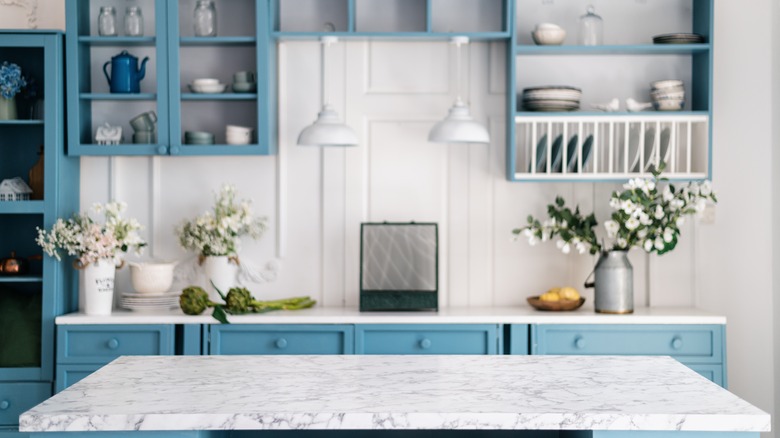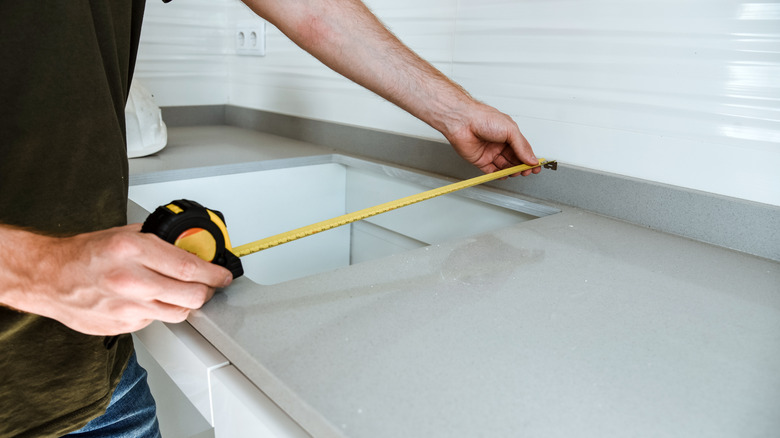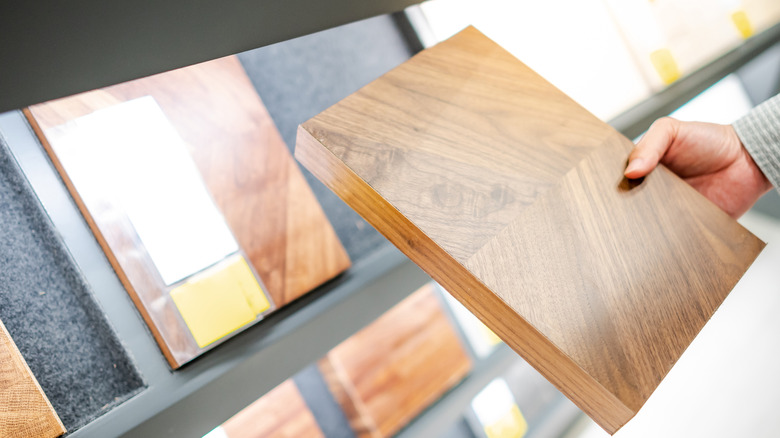How To Bring New Life To Your Kitchen Countertops Without Replacing Or Painting Them
Kitchen remodels are usually high on everyone's home renovation list, and our countertops are often a top contender for replacement with how high traffic they are. The wear and tear of our kitchen countertops could arguably be unrivaled compared to other areas of the home with how much meal prep, dishwashing, wine pouring, and to-do list planning they experience on a daily basis. Even so, replacing kitchen countertops is an expensive endeavor — the average national cost is $3,102 based on a series of factors such as your kitchen's layout and size, the materials you're using, and the cost of labor. But, there are alternatives to complete replacement that will be easier on your bank account, like countertop overlays and sheet laminate.
Painting kitchen countertops tends to be another idea many people have, but the caveats with this are not always worth the time and money spent. Paint is not nearly as durable as other alternatives, chipping and staining easily. However, countertop overlays and sheet laminate can produce reliable and long-lasting results at affordable price points without the hassles and time consumption that come with complete replacement or painting. With such quick solutions that don't require you to rip apart the kitchen, these are especially great options for renters or those flipping properties for a rapid turn-around investment.
Quartz and granite countertop overlays
Countertop overlays are a niche section of kitchen remodeling trends, and it's sometimes challenging to find contractors who make and install them. These overlays are precut slabs of quartz or granite, 13 millimeters thick, and placed on top of your countertops. No removal or demolition is required, only a temporary shut-off of plumbing, and these can be installed in just one day. The precast slab will be measured and cut to the proper size of your countertops and professionally installed. Independent contractors in your area may provide these services, or Lowe's offers online inquiries.
While considering countertop overlays, you'll want to ponder whether you prefer granite or quartz. Granite is an entirely natural stone with various colors and patterns available, while quartz is primarily a natural stone with a small percentage manufactured, giving a more durable and robust quality. Whether quartz or granite is more expensive depends on different factors including availability and treatments used. A few drawbacks to consider with overlays are that you need to have sturdy and even existing countertops as a base. This won't be a solution for any structure issues your countertops have, and it is not a remodel, despite how it may feel. You won't be able to change the layout or shape of your countertops; it is only laying down a new surface over the existing design.
Laminating over countertops
Laminate countertops are not only affordable but also very accessible and easy to DIY. Of course, the designs to choose from are endless, with patterns of natural stone, woods, and various colors available. Laminates are found to be quite durable, standing firm against stains and scratching, but they don't have an excellent track record with heat. The average cost for placing laminate over your countertops is about $35 per square foot and an additional $30 to $40 an hour for labor if you hire professional help. But, it is very doable to skip the hired help and complete this project yourself in just a few hours.
Contact cement is used to apply the laminate for the longest-lasting results. Cheap peel-and-stick laminate options are available in department stores or on Amazon, but those aren't necessarily meant to last more than a few years. You'll find your laminate lasting well over a decade with contact cement and proper installation. Start by sanding your countertops and removing any gloss and paint that may affect the application. Next, measure and cut the laminate to size, adding roughly an inch to each side for the countertop's edges. Apply the contact cement to the underside of the laminate and carefully place it over the counters. Dowel rods can aid in this process, and you'll want to trim up any overhang. Use caulk to seal and cover any visible seams, and you'll have yourself new countertops.


